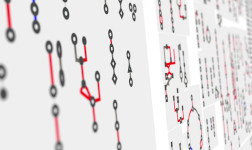Hauptinhalt
Topinformationen
Pressemeldung
Nr. 101 / 2021
03. November 2021 : Apparently, opposites attract in bacteria as well – Ecologists at Osnabrück University identify a new rule on how bacterial communities form.
The fact that different bacterial strains interact with each other and exchange substances is essential, for example, for the production of yogurt or in maintaining our healthy intestinal flora. But how do bacteria choose their interaction partners? The research group of ecologist Prof. Dr. Christian Kost at Osnabrück University has now investigated this question using the example of amino acids, which are exchanged between two bacterial strains. Together with colleagues from Kiel University, the study was published in the journal Current Biology. The findings contribute significantly to a better understanding of the factors that determine the formation of a microbiome.
Kost and his team had taken a closer look at natural communities of bacteria. “We focused on interactions, in which a bacterial strain can only survive if it is provided with amino acids by another strain. We call such a recipient strain 'auxotrophic.' Here we wanted to find out whether the auxotrophic bacterial strain can grow when it is combined with completely different bacterial strain, and if so, which factors determine whether such a coculture with another species is successful," says Prof. Kost, explaining the methodological approach.
In the laboratory, they allowed auxotrophic bacterial strains from two different bacterial species to grow together with 25 other strains of the same or a different bacterial species. With the result: in more than 60% of all cocultures, auxotrophic bacterial strains were able to grow when a different type of bacterium was present. "Interestingly, we saw: The more different two bacterial strains were, the more likely they were to successfully establish a metabolic cross-feeding interaction." Kost said. The interaction formed very quickly and spontaneously and, according to the observation, did not require additional evolutionary adaptations.
Prof. Dr. Silvio Waschina from the Institute of Human Nutrition and Food Science and Prof. Dr. Christoph Kaleta from the Institute of Experimental Medicine at Kiel University verified the findings obtained in the Osnabrück laboratory with a computer model. To do this, they analyzed the bacterial community in a human intestine and investigated the extent, to which the same patterns could be predicted based on the genomes and the resulting metabolic networks. "The computer model also revealed the exact same pattern: metabolic cross-feeding interactions were significantly more likely when two different partners interacted with each other, than when both bacteria belonged to the same species," said Prof. Kaleta of Kiel University.
The findings have a high biotechnological relevance, summarizes Prof. Kost: "With this work, we have described a new principle that can be used to explain the formation of bacterial communities based on certain interactions. This principle is of biotechnological importance, for example, when different strains are to be cultivated with each other in order to produce certain substances. Our findings can thus be used to design more stable and efficient artificial bacterial communities."
Link to publication: https://www.cell.com/current-biology/fulltext/S0960-9822(21)01408-1
Information for editors:
Prof. Dr. Christian Kost
Department of Ecology
Phone: +49 541 969-2853
christian.kost@uni-osnabrueck.de






